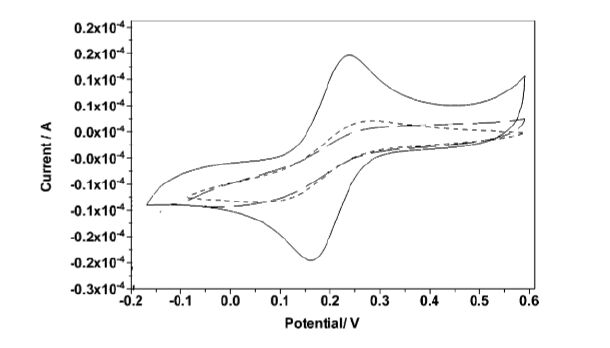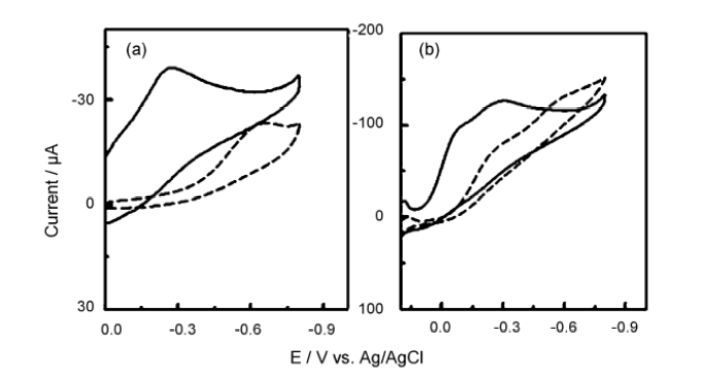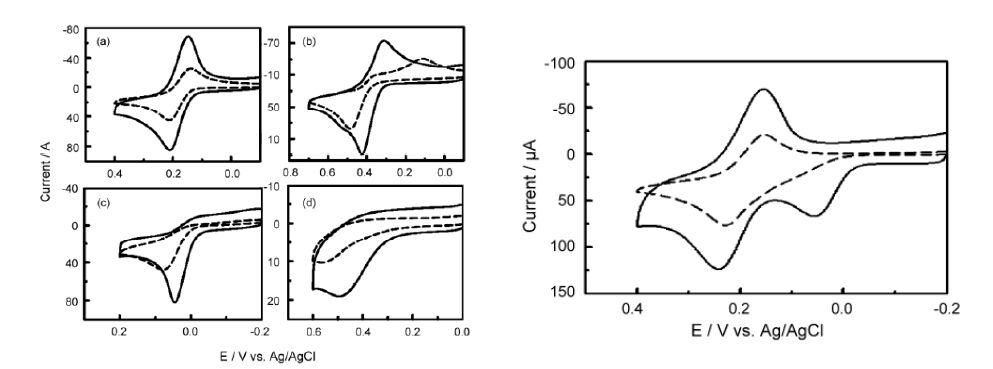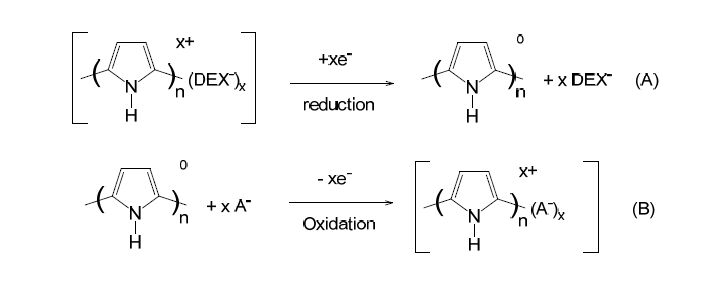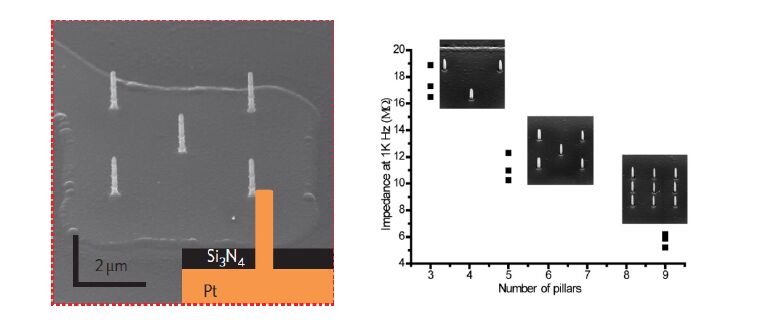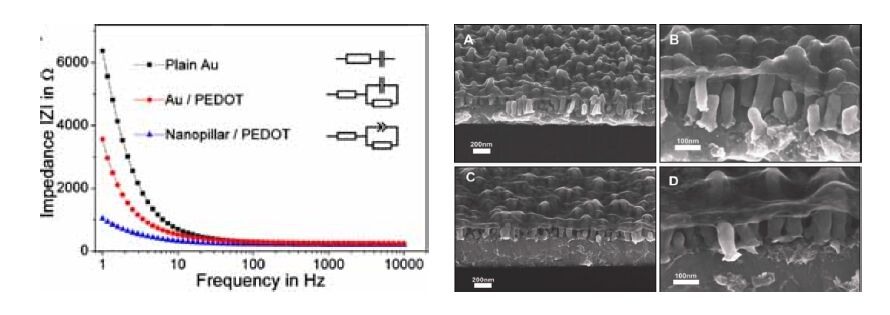1. Introduction
Electrochemistry involves the study of the electrical aspect of chemistry, namely chemical reactions occurring on electrodes. The electrodes include both an anode and a cathode. The redox reactions at the electrodes involve the gain and loss of electrons at electroactive surfaces. Results of electrochemical analysis depend on the size of electrochemically active surface area [1,2].
The use of nanopillars as a surface material for electrodes is widespread, and for a good reason. The electrochemical properties of nanopillars determine their applications, which range from biosensors to magnetic random access memory chips and from photovoltaic devices to flat panel displays. The introduction of nanopillars has three effects on the electrochemistry on electrodes: increasing surface area and electroactive surface area; enhancing the conductive capability; and lowering the double layer capacitance.
1.1. Increasing Total Surface Area and Electroactive Surface Area
Nanopillars provide increased surface area on electrodes, which leads to greater sensitivity and signal discrimination. Researchers have developed nanopillars on both cathodes and anodes with a higher total surface area and electroactive surface area than the flat surface. Because of an improved signal-to-background ratio, the nanopillar array electrodes are electrochemically favorable to use. They would be suitable for the detection of electrochemical and electrocatalytic behaviors [3].
The electroactive surface area is different from the total surface area, as reported from several groups using various methods.
The total surface area depends on the density and size of nanopillars. It can be calculated by using a simple geometrical method [4],
|
Stotal = S0 + 2 π nrl
|
(1)
|
where S0 is the geometric area of the electrodes, n refers to the number of nanopillars in the area, r is the radius of the nanopillars, and l is the height.
As for the electroactive surface area, since the electrochemical processes occurring at the electrodes were found to be linear-diffusion-driven processes, Anandan et al. [4] used the Randcles-Sevcik equation to relate the peak current to the electroactive surface area since the peak current is proportional to the electrochemically active surface area for diffusion-based electrode reactions:
|
IP = 2.69 × 105An3/2D01/2C0v1/2
|
(2)
|
where IP is peak current, C0 is the original concentration of the electrolyte used, n is the number of electrons involved in the reaction, v is the potential sweep rate, A is the electroactive surface area, and D0 is the diffusion coefficient of the electrolyte.
In Anandan's work, the total surface area with nanopillars is 12 times greater than that of the electrode without nanopillars. The peak current of electrode with nanopillars [1451.8 µA/(mM·cm2)] is 7 times greater than that of the electrode without nanopillars [199.3 µA/(mM·cm2)], suggesting the electroactive surface area of nanostructured electrode is only 7 times greater than that of the planar electrode. The result demonstrated the difference between the total surface area and electroactive surface area of nanostructured electrodes.
Zou et al. [1] also used the Randcles-Sevcik equation (equation 2) to calculate the electroactive surface area of their boron doped diamond nanopillar arrays on nanocrystalline diamond (ND) film electrodes, compared to that of planar boron doped ND film electrodes. In this case, the total surface area increased by 4 times for the electrode with nanopillars, but the nanopillars were found to only increase electroactive surface area by 42% compared to the flat electrode.
These results suggested the shape, density, length, etc. of the nanopillars played important roles in determining the electroactive surface of the nanostructured electrodes.
In another work, Schröper et al. also compared surface areas of gold nanopillars with planar gold electrodes [5]. In this system, Au-oxide reduction was used to measure the electroactive surface area through observation of charge transfer processes for diffusion controlled systems, where the access of analyte to the surface is controlled by semi-infinite planar diffusion. Based on the peak currents for diffusion limited electrode responses, the electroactive surface area of an electrode with nanopillars was found to be about 1.45 times that of one without nanopillars. Based on the non-diffusion controlled system, the electroactive surface area showed a 5.9 fold increase in surface area compared to planar electrodes. The electroactive surface area from non-diffusion controlled system seemed to be closer to the total surface area increase factor of 7.1 fold measured from SEM.
Other surface bound redox system by Schröper et al. involved redox active species, such as hexacyanoferrate, K4[Fe(CN6)], and cytochrome c, on the surfaces. They compared the total surface area measured from SEM with electroactive surface area from different electrochemical measurements. The immobilized redox system had similar results, i.e., the non-diffusion controlled system provided an electroactive surface area number closer to the total surface area obtained from SEM, and in both cases, the electroactive surface areas on nanopillar electrodes are larger than those on a planar electrode.
It was apparent from these experiments that the electroactive surface area does not equal the total surface area. One conclusion is that not all of the nanopillar surface is involved in the electrochemical reactions occurring on an electrode for diffusion controlled methods because of lack of accessibility to the entire nanopillar. The electroactive surface area values from non-diffusion controlled method was closer to the total surface area than diffusion controlled methods for determining electroactive surface area, although they too were not the most accurate for estimating total surface area.
1.2. Enhancing the Conductive Capability
In most, if not all cases, it is expected that the addition of nanopillars will improve the conducting capabilities of the surface. This is because that the quantum-sized dimensions of the nanopillar arrays result in greater electrocatalytic abilities than those on the flat electrodes [3]. At the tip of the nanopillars, the electric field emitted can be modeled by the equation:
where g and h are parameters (given as 1.6 × 108 m−1 and 2.5 × 107 m−1 respectively) that relate to specific electrode geometry, Vg is the gate voltage and Va is the anode voltage. While parameters like anode-cathode distance may vary, the equation should still provide a reasonable value [6]. The electrode geometry, used in the equation above, is one of the reasons for using nanopillars on cathodes. The geometric field enhancement factor resulting from nanopillars on cathodes leads to a lower turn on voltage for the devices, making the nanostructures a very appealing inclusion on various electronics [7].
1.3. Decreasing Double-Layer Capacitance
The nanoelectrode arrays are suitable for use in quick electrochemical measurements with high sensitivity because of their low double layer capacitance and low RC time constant [8]. Schröper et al. calculated double-layer capacitances (Cdl) by using the following equation [5]:
where ∆I is the current difference between positive and negative circular voltammetry cycles and v is the scan rate of the cycles. Compared to planar gold electrodes, nanopillar array electrodes have higher charging currents for double layer capacitance, i.e., lower double-layer capacitance, because of the surface modifications.
In summary, nanopillar modified electrodes have demonstrated several advantages in electrochemistry compared to flat electrodes. The only disadvantage reported so far is the higher percentage of defect when modified with self-assembled monolayers (SAM), perhaps due to the shape of the nanopillars [9]. This review briefly summarizes recently studies in this area involving cyclic voltammetry, impedance, chronoamperometry, and cathodes and anodes with regards to nanopillars.
2. Cyclic Voltammetry
Cyclic voltammetry (CV) allows determination of redox peaks based on a potentiodynamic electrochemical measurement. By employing current measurement comparisons, it is feasible to determine whether nanopillar electrodes can serve as better electrodes, in terms of current and sensitivity, than planar ones. Some of the work from several groups are summarized in Table 1 and will be discussed in the following paragraphs.
Table 1. The comparison of studies that used cyclic voltammetry for varying purposes.
| Authors |
Redox reaction |
Material, size, and density of nanopillars |
Results
|
| Zou et al. [1] |
[Fe(CN)6]3− and [Fe(CN)6]4− |
Diamond nanopillars with an average diameter of 130 nm and height of 900 nm |
The nanopillar array electrode displayed greater cathodic and anodic current responses than flat film electrode, with an increase in current density by 1.42 times.
|
| Valsesia et al. [8] |
hexacyanoferrate (Ⅱ/ⅡI) |
Polypyrrole (PPy) nanopillars with an average diameter of 60 nm for the 500 nm pattern and 171 nm for the 1000 nm pattern |
The CVs of the nanoelectrode arrays have the typical sigmoidal shape, but not the typical redox shape (Figure 1), so PPy nanopillar array is suited for fast electrochemical measurement. Surface areas were not compared.
|
| Leprince et al. [10] |
Redox of PPy. Electrical stimulus to release dexamethasone (DEX) |
Diameter of about 150 nm for the platinum nanopillars coated with polypyrrole |
The redox peaks occurred at lower values for the nanoelectrodes than the values for planar electrodes, which is due to the effects of nanopillars on the film's electrochemical properties. Surface areas are not compared.
|
| Shin et al. [3] |
Reduction of AuO at 0.9 V.
H2O2, O2, dopamine, p-acetamidophenol, ascorbic acid, uric acid, Fe(CN)63−/4−, Ru(NH3)62+/3+ |
Au nanopillar array electrode (AuNPE) |
Electroactive surface area increases by 4.6 times for the AuNPE electrode when compared to a planar gold electrode.
The diffusional redox peak current for these species are all higher and for the AuNPE compared to the bare Au electrode, but the rates are not much enhanced by the increased surface area.
|
In general, planar electrode and nanopillared electrodes displayed similar electrochemical responses, but different amplitudes, on voltammograms. The results indicate that nanopillars speed up electron transfer and enhance the electrochemical response of a slow kinetic reaction.
There are also cases the peaks shifted. For example, for the reduction of hydrogen peroxide and molecular oxygen, the reduction peaks on nanopillared surface were positively shifted compared to the peaks for a planar electrode (Figure 2) [3]. The reason for the shifts is most likely caused by the quantum sized dimensions of the nanopillars. Driskill-Smith et al. also looked into these quantum-interference effects [6], which occur between the anode and the electron wave function located on the tip of the nanopillar field emitter. They concluded that these effects cause time independent fluctuations in current-voltage characteristics in anodes.
Shin et al. [3] showed that nanopillar electrode can discriminate species through voltammetric signals, something that was not seen in the bare Au thin film electrode. For example, the peak for the oxidation of glucose was distinct from the peaks from interfering compounds like ascorbic acid, acetamidophenol, and uric acid (Figure 3). These properties make the AuNPE electrode very promising for an electrochemical sensor.
Leprince et al. [10] employed CV to apply an electrical stimulus in order to trigger the release of dexamethasone (DEX) from the polypyrrole (PPy) coated nanopillar-electrodes (Figure 4).
The reduction peak on the voltammogram occurred at −0.2 V, while the oxidation peak occurred at 0.15 V for PPy/DEX films on electrode nanostructures; both peaks occurred at lower values for the nanoelectrodes than the values for planar electrodes. This lower value is attributed to the effects of nanopillars on the film's electrochemical properties, as an increase in electroactive surface area. A benefit of the lower peaks means release of DEX can occur at lower applied voltages. The amount released after 150 CV cycles for both a thick (700 mC/cm2) and thin (27.4 mC/cm2) PPy/DEX film is 106 and 39 µg/cm2, respectively. Those amounts are enough to trigger the anti-inflammatory effects of DEX on surrounding tissue.
3. Impedance
In electrochemical devices, high impedance results in low efficiency in signal transduction. In order to advance biosensors and biotechnology, researchers have been developing techniques to create nanoelectrodes with low impedance. The addition of nanopillars on electrodes has resulted in varying degrees of success. The investigation is ongoing for different dimensions and materials to create better nanoelectrodes with numerous applications.
Xie et al. [11] created electrodes (Figure 5 left) for extracellular recording of action potentials and reported that by lowering impedance at the electrode-cell membrane connection, signal collection would become more efficient, allowing for accurate and long term signal recording. The vertically aligned nanopillars used created a tight cell-nanopillar electrode interface. Through transient electroporation, inducing nanometer sized pores in a membrane using a high electric field, the cell became more permeable. The decreased the impedance between the cell interior and the electrode resulted in a signal-to-noise ratio of 590, approximately 100 times of that of typical nanowire field-effect transistors. Xie et al. [11] also showed that electrical impedance of a chip with nanopillars noticeably decreased as more nanopillars were added (Figure 5 right).
Gardner et al. [12] reported the impedance decreases due to increasing nanopillar height of a Co-Ni-Cr-Mo (MP-35N) alloy and thus larger surface area. Previously, nanopillar height was between 1-3 μm. The increase in height from 1-3 μm to 10 μm reduced electrode impedance to about one fifth of the impedance in unprocessed MP-35N wires. This reduction holds true for signals under 100 Hz, in a phosphate-buffered saline solution. However, it should be noted that the increase in surface area significantly lowers impedance only at low frequencies due to high influence of electrode-electrolyte surface characteristics. At higher frequencies, increasing the surface area, while decreasing impedance, does not have as big of an effect because the dominate factor is the movement of ions in the electrolyte for the electrochemical activity on the nanopillar surface.
Sanetra et al. [13] reported that thin coatings of under 100 nm of conductive polymer poly(3,4-ethylenedioxythiophene) with polystyrene sulfonic acid (PEDOT/PSS) on gold (Au) nanopillar electrodes (Figure 6) results in low impedance electrodes. Electrochemical impedance spectroscopy was performed to determine the impedance of PEDOT/PSS Au nanopillar electrodes versus polymer free planar gold electrodes and PEDOT/PSS planar electrodes. The nanopillars had an average diameter of 50 nm, height of 200 nm, and spacing of 30 nm. The conductive polymers are biocompatible and facilitate electron transfer between biological materials and electrodes. The polymer modified gold nanopillar electrodes had the lowest impedance. The contribution of increased electroactive surface area to decreased impedance was determined by double layer capacitance measurements. For a nanopillar electrode, it is found that the thinnest coating of the polymer results in a lower capacitance than a nanopillar electrode without the polymer coating because thin films can adapt to the nanopillar surface better and enhance electroactive surface area, and thus reducing impedance. With a coating of 30 nm, the Au nanopillar electrode had a decreased impedance by a factor 2.5 at 1 Hz when compared to the impedance of a PEDOT/PSS planar electrode. However, as polymer thickness increases, the coated nanopillar electrodes demonstrate higher capacitance than uncovered ones, because the surface area of nanopillars decreases with increased PEDOT/PSS coating thickness.
Also, there is a significant difference in impedance by a factor of 7 between uncoated planar gold electrodes and uncoated gold electrodes with nanopillars due to an increase in electroactive surface area.
4. Chronoamperometry
Another electrochemical test used on various nanopillar arrays is chronoamperometry, which measures current change as a function of time after a potential to cause an electrochemical reaction is applied to the working electrode. Anandan et al. [14] used it to determine the sensitivity of nanopillars. The onset of oxidation of K4Fe(CN)6 was 0.25 V, in reference to Ag/AgCl potential; the chronoamperometric tests were performed at that voltage. In a comparison of the responses exhibited by a gold plated nanopillar array electrode and a flat gold electrode, the gold nanopillar array displayed a steady state current eight times that of the flat electrode. This corresponds to the enhanced electrode sensitivity due to the nanopillars.
5. Conclusion
In conclusion, the addition of nanopillars to electrodes results in a higher electroactive surface area when compared to planar electrodes, resulting in greater electrochemical capabilities and more efficient electrodes. In many of these reactions, the nanopillars decreases the impedance and improves the functionality of the electrodes. Nanopillars also provide other advantages on electrodes, such as reducing cracking because of their smaller shape on a surface [15]. Because of its unique geometry, nanopillars on electrodes make them useful in a great deal of applications in electrochemical fields.
Conflict of Interest
The authors declare that there is no conflict of interest regarding the publication of this manuscript.









 DownLoad:
DownLoad: 